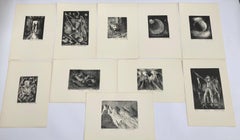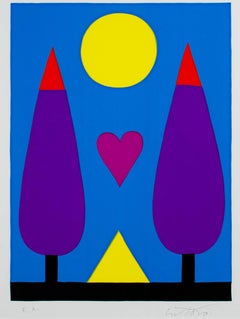Carlos Slim
1980s Modern Figurative Prints
Etching
1970s Prints and Multiples
Screen
Carlos Slim For Sale on 1stDibs
How Much is a Carlos Slim?
Jonathan Becker for sale on 1stDibs
With a style at once impactful, reflective and irreverent, photographer Jonathan Becker belongs more to the artistic than the documentarian realm, masterfully capturing a theatrical sense of the unexpected as he offers glimpses into rarefied worlds.
Bea Feitler — the late, legendary artistic director responsible for vamping up Harper’s Bazaar and Rolling Stone in the 1960s and ’70s — gave Becker his first big break, in 1981, when she asked him to submit images for the relaunch of Vanity Fair.
Becker, who was 26 at the time, had already been the first Paris-based photographer for W magazine and had forged a close friendship with French-Hungarian Surrealist photographer Brassaï, who was then in his 70s. By this age, too, Becker had also developed an enviable reputation as a portrait photographer working on Andy Warhol’s Interview magazine and alongside Slim Aarons and Norman Parkinson at Town & Country, although he knew not to step on his famous colleagues’ toes. “I was a young little interloper,” he says. “I learned more by listening and watching those giants than by trying to engage in any direct interactions with them.”
The young photographer, who was moonlighting at the time as a New York City cab driver, hadn’t dreamed that the project would put his pictures on an equal footing with those of legends of the medium: Also contributing to this debut edition were some of photography’s most revered names, including Richard Avedon, Irving Penn and Helmut Newton, as well as rising star Annie Leibovitz, whose popularity had recently skyrocketed, thanks to her Rolling Stone cover picture of a naked John Lennon curled up alongside a fully clothed Yoko Ono.
That issue was a game changer in modern magazine publishing, with Vanity Fair setting the bar for engaging editorial and daring design for decades to come. It also signaled the making of a man: Becker’s talent for visual storytelling shone through in his avant-gardist tribute, and the magazine’s creative team kept him on, marking the start of his long career there.
As a regular Vanity Fair contributor, Becker operated in the highest echelons of society, traveling the world and immortalizing countless A-list movers, shakers and thinkers from the fields of fashion, culture and politics, not to mention royalty.
Becker's unconventional way of directing his eye is clearly instinctual, resulting in an unusual aesthetic that mixes perception, myth and reality in equal measure. This balance is most apparent in his famous black-and-white picture of Robert Mapplethorpe, taken in 1988 at the opening of Mapplethorpe’s retrospective exhibition at the Whitney, when the famed photographer was dying of AIDS. It is a group shot, showing various figures at different angles, in which Mapplethorpe, caught in profile and listening intently to a woman kneeling beside him, seems to stop time. The moment is heavy with emotion and also dreamlike. It is ineffably surreal.
Becker has given us Stephen King as a cross-eyed zombie (1980); Dustin Hoffman as a mischief maker, lounging on a stack of sun loungers at the Beverly Hills Hotel (2004); and Diana Vreeland as an aging Raphaelesque Madonna dressed in a voluminous black gown and sitting cross-legged in her famous red-clad living room at 550 Park Avenue (1979). The photographer, a lover of spontaneity who deftly plays with perspectives, keeps us intrigued with his open-ended narratives.
Find a collection of Jonathan Becker photography on 1stDibs.
A Close Look at Contemporary Art
Used to refer to a time rather than an aesthetic, Contemporary art generally describes pieces created after 1970 or being made by living artists anywhere in the world. This immediacy means it encompasses art responding to the present moment through diverse subjects, media and themes. Contemporary painting, sculpture, photography, performance, digital art, video and more frequently includes work that is attempting to reshape current ideas about what art can be, from Felix Gonzalez-Torres’s use of candy to memorialize a lover he lost to AIDS-related complications to Jenny Holzer’s ongoing “Truisms,” a Conceptual series that sees provocative messages printed on billboards, T-shirts, benches and other public places that exist outside of formal exhibitions and the conventional “white cube” of galleries.
Contemporary art has been pushing the boundaries of creative expression for years. Its disruption of the traditional concepts of art are often aiming to engage viewers in complex questions about identity, society and culture. In the latter part of the 20th century, contemporary movements included Land art, in which artists like Robert Smithson and Michael Heizer create large-scale, site-specific sculptures, installations and other works in soil and bodies of water; Sound art, with artists such as Christian Marclay and Susan Philipsz centering art on sonic experiences; and New Media art, in which mass media and digital culture inform the work of artists such as Nam June Paik and Rafaël Rozendaal.
The first decades of the 21st century have seen the growth of Contemporary African art, the revival of figurative painting, the emergence of street art and the rise of NFTs, unique digital artworks that are powered by blockchain technology.
Major Contemporary artists practicing now include Ai Weiwei, Cecily Brown, David Hockney, Yayoi Kusama, Jeff Koons, Takashi Murakami and Kara Walker.
Find a collection of Contemporary prints, photography, paintings, sculptures and other art on 1stDibs.
Finding the Right Photography for You
Find a broad range of photography on 1stDibs today.
The first permanent image created by a camera — which materialized during the 1820s — is attributed to Joseph Nicéphore Niépce. The French inventor was on to something for sure. Kodak introduced roll film in the 1880s, allowing photography to become more democratic, although cameras wouldn’t be universally accessible until several decades later.
Digital photographic techniques, software, smartphone cameras and social-networking platforms such as Instagram have made it even easier in the modern era for budding photographers to capture the world around them as well as disseminate their images far and wide.
What might leading figures of visual art such as Andy Warhol have done with these tools at their disposal?
Today, when we aren’t looking at the digital photos that inundate us on our phones, we look to the past to celebrate the photographers who have broken rules as well as records — provocative and prolific artists like Horst P. Horst, Lillian Bassman and Helmut Newton, who altered the face of fashion and portrait photography; visionary documentary photographers such as Gordon Parks, whose best-known work was guided by social justice; and pioneers of street photography such as Henri Cartier-Bresson, who shot for revolutionary travel magazines like Holiday with the likes of globetrotting society lensman Slim Aarons.
Find photographers you may not know in Introspective and The Study — where you’ll read about Berenice Abbott, who positioned herself atop skyscrapers for the perfect shot, or “conceptual artist-adventurer” Charles Lindsay, whose work combines scientific rigor with artistic expression, or Massimo Listri, known for his epic interiors of opulent Old World libraries. Photographer Jeannette Montgomery Barron was given a Kodak camera as a child. Later, she shot on Polaroid film before buying her first 35mm camera in her teens. Barron's stunning portraits of Jean-Michel Basquiat, Warhol and other artists chronicle a crucial chapter of New York’s cultural history.
Throughout the past two centuries, photographers have used their medium to create expressive work that has resonated for generations. Shop a voluminous collection of this powerful fine photography on 1stDibs. Search by photographer to find the perfect piece for your living room wall, or spend some time with the work organized under various categories, such as landscape photography, nude photography and more.

